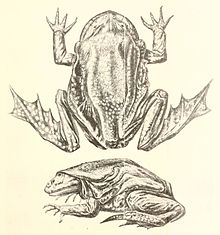Titicaca water frog
| Titicaca water frog | |
|---|---|
 |
|
| Illustration by Samuel Garman, 1876 | |
| Scientific classification | |
| Kingdom: | Animalia |
| Phylum: | Chordata |
| Class: | Amphibia |
| Order: | Anura |
| Family: | Telmatobiidae |
| Genus: | Telmatobius |
| Species: | T. culeus |
| Binomial name | |
|
Telmatobius culeus (Garman, 1876) |
|
Telmatobius culeus, commonly known as the Titicaca water frog, is a very large and critically endangered species of frog in the family Telmatobiidae. It is entirely aquatic and only found in Lake Titicaca and rivers that flow into this lake in the Andean highlands of South America. In reference to its excessive amounts of skin, it has jokingly been referred to as the Titicaca scrotum water frog.
It is closely related to the smaller, more widespread and semi-aquatic marbled water frog (T. marmoratus), which also occurs in coastal parts of Lake Titicaca.
While the lungs are greatly reduced, this frog has excessive amounts of skin, used to help the frog respire in the cold water in which it lives. The color is highly variable, but generally gray, brown or greenish above, and paler below.
In the early 1970s, an expedition led by Jacques Cousteau reported frogs up to 50 cm (20 in) in outstretched length and 1 kg (2.2 lb) in weight, making these some of the largest exclusively aquatic frogs in the world (the fully aquatic Lake Junin frog is larger, as is the African goliath frog, which sometimes can be seen on land). The snout-vent length is typically 7.5–13.8 cm (3.0–5.4 in). Females grow larger than males.
The Titicaca water frog spends its entire life in oxygen-rich water that typically is 10–17 °C (50–60 °F). It mainly stays near the bottom and it does not surface to breathe if the water is well-oxygenated. It regularly performs "push-ups" to allow water to pass by its large skin folds, which absorb oxygen. It occurs even in deeper parts of Lake Titicaca, although the limit is unknown. The Titicaca water frog feeds on amphipods, insects, snails, tadpoles and fish (including Orestias). It has an extremely low metabolic rate; below that of all other frogs. Breeding is in shallow, coastal water where the female lays about 500 eggs.
...
Wikipedia

